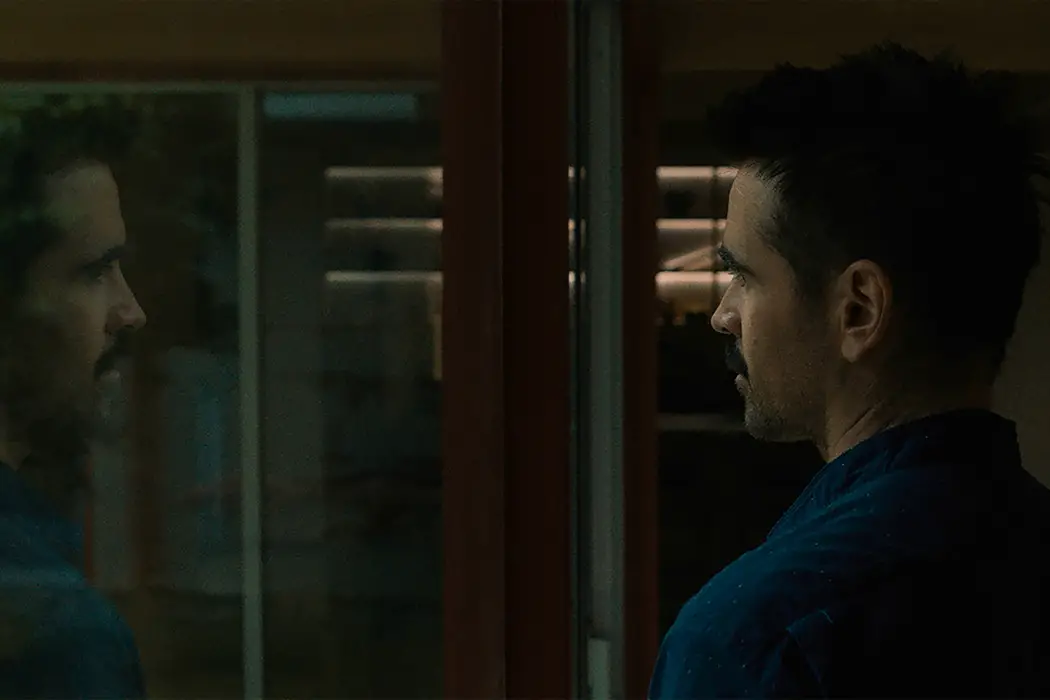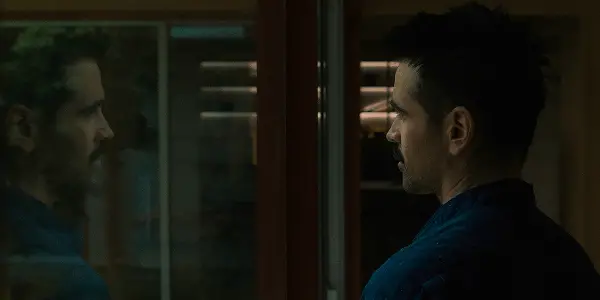Sundance Film Festival 2022: AFTER YANG: A Portrait of Memories and Heartache

Kevin L. Lee is an Asian-American critic, producer, screenwriter and…
There is a beautiful moment in After Yang, where Colin Farrell’s Jake interacts with Yang (Justin Min) about the intricacies and distinct experiences in making and drinking tea. Jake tries his best to explain his feelings to Yang, and Yang does his best to understand, but Jake settles by saying he simply doesn’t have the language for it.
Writing about After Yang is a similar experience. I can say that it’s a meditative exploration of grief and coming to terms with someone’s absence. I can also say that it’s an examination of how we hold onto memories and how we choose to remember someone we love. In terms of ideas in the science-fiction genre, we’re very much in Don Hertzfeldt territory here –exactly the kind of poignant, deeply human experience that the genre should embrace more frequently. But Kogonada directs After Yang with a subliminal effect. He presents a series of images and visuals, sometimes shown on repeat, and with the right music and sound design, it strikes something deep in the human soul.
A Headspace to Linger In
Instead of starting with an explanation of its rules, Kogonada establishes the most important thing in his story, that is the lead family, consisting of Jake, his wife Kyra (Jodie Turner-Smith), and their children Mika (Malea Tjandrawidjaja) and Yang. They live comfortably, in a beautiful house. They enjoy dinner together and compete in a virtual dance competition, held across the world over tens of thousands of other families, resulting in one of the most satisfying opening credits sequences in recent memory.
It is here where Yang suddenly malfunctions. He won’t wake up – or “start up” – anymore. That is when we learn that Yang is actually an android, or as the film calls it, a technosapien.

With that terminology comes a whole world and culture in After Yang, that Kogonada introduces carefully via Jake’s efforts to fix Yang. Never once does the film provide information to the audience in the form of an exposition dump. Rather, each revelation unfolds based on each step Jake has arrived at. What starts as a simple trip to the repair shop becomes more complex when Jake discovers a never-before-seen piece of technology lying inside Yang’s operating system. Meanwhile, the farther Jake goes, the more Kyra and Mika feel Yang’s absence.
Whether he is writing a standard drama or a piece of science fiction, Kogonada is a filmmaker who always prioritizes living in a headspace. In this case, it is a sophisticated look at grief. The more After Yang progresses, the more obvious it becomes that Yang’s malfunction is no different from a death in the family. But the script doesn’t just explore that void. It goes a step further and asks how we choose to remember our loved ones. Memory is such a tricky thing, which is what sets After Yang apart from other sci-fi films. Most stories about artificial intelligence would simply talk about the humanity behind the machine, but After Yang further complicates that notion by exploring the power of memory.
The Privacy of Memory
A significant turning point of the film is when Jake meets a museum curator named Cleo (Sarita Choudhury), who reveals that the rare piece of technology inside Yang is a system to store important memories across his “life.” Given that Jake went through a second-hand purchase to have Yang, he decides to have Yang’s memories downloaded and accessed to see what he experienced prior to joining their family.
It’s an ingenious setup for us to not only learn who Yang was as a person, as a living being but to also see what he considers to be “important.” The result is just fragments, but they’re beautiful fragments. Seconds of seeing a tree swing, of sunlight peering through the window, of seeing himself in the mirror. A kaleidoscope of images that seem trivial at the moment but become the only thing we remember when our lives flash before our eyes. During these memory sequences, the musical score by ASKA works wonders. It brings back fond memories of Antonio Pinto’s violin work in Nine Days – both use music to tap into something spiritual and powerful.
In Yang’s memories, Jake constantly sees the same young woman, who is later revealed to be Ada (Haley Lu Richardson), another techno sapien with who Yang may have shared a special, romantic connection. And with this subplot, Kogonada completes another important step in grieving a loved one – understanding what kind of person they were to someone else, someone else who you’ve never met.
Soon, Jake and his family have to make a decision about what to do with Yang and his memories. Should he be kept at the museum? Is it preservation? Or is it memorialization? These are questions that might just emotionally blindside you, as you attempt to put yourself in the family’s shoes and make a decision for them.
After Yang: Essential Science Fiction Viewing
In addition to Kogonada’s pensive writing, the film is immaculate on a technical level. The beautiful cinematography and architectural design offer a stark contrast between the world these characters live in and the messy headspace each character has to wrestle with; the latter is already a component he perfected in his previous film Columbus.
Such a simple, self-contained story allows room for the entire cast to shine. Farrell and Turner-Smith share a delicate, sensitive chemistry on screen that trickles down to their relationship with Tjandrawidjaja. With Jake being white, Kyra being Black, and Mika being Chinese, another component behind having Yang join the family is to help Mika connect to her Asian heritage. But that opens up another conversation about Yang representing the struggles of being Asian-American, that is a lot of our Asian-ness comes from knowing facts instead of… well… living.
The last hour of After Yang sees every possible angle of grief converging together. At some point, the tears suddenly came, and within seconds, I was inconsolable. It is exactly the kind of meditative, tender, and thematically rich story you would expect and hope to get from Kogonada’s second film. 101 minutes have never breezed by this quickly before. Not only is it one of the best films of the year so far, but it might also already be one of the best films science fiction has to offer.
What did you think of After Yang? Let us know in the comments below!
After Yang had its North American premiere at the Sundance Film Festival on January 21, 2022. It will eventually be released in theaters in the US by A24.
Does content like this matter to you?
Become a Member and support film journalism. Unlock access to all of Film Inquiry`s great articles. Join a community of like-minded readers who are passionate about cinema - get access to our private members Network, give back to independent filmmakers, and more.
Kevin L. Lee is an Asian-American critic, producer, screenwriter and director based in New York City. A champion of the creative process, Kevin has consulted, written, and produced several short films from development to principal photography to festival premiere. He has over 10 years of marketing and writing experience in film criticism and journalism, ranging from blockbusters to foreign indie films, and has developed a reputation of being “an omnivore of cinema.” He recently finished his MFA in film producing at Columbia University and is currently working in film and TV development for production companies.













